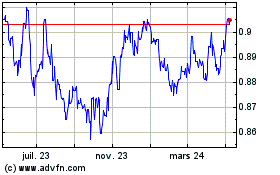Commodity Currencies Slide
30 Mai 2023 - 4:32AM
RTTF2
Commodity currencies such as the Australia, the New Zealand and
the Canadian dollars weakened against their major rivals in the
Asian session on Tuesday, as most Asian stock markets traded lower,
following the lack of cues from global markets overnight due to
holiday in most markets, as traders turned to booking profits after
the recent rally in some markets.
Traders also remain cautious ahead of the vote on the U.S. debt
ceiling deal on Wednesday.
U.S. President Joe Biden and Congressional Republican McCarthy
agreed on a debt ceiling deal on Saturday to avert an economically
destabilizing default by suspending the $31.4 trillion debt ceiling
until 2025. The bipartisan agreement now has to clear a divided
Congress before the United States runs out of money to pay its
debts in early June.
In economic news, data from the Australian Bureau of Statistics
showed that the nation's building approvals fell 8.1 percent after
a drop of 1.0 percent in March. Economists had expected a rise of
2.0 percent.
Data from Statistics New Zealand showed that the nation's
building approvals fell 2.6 percent in April, reversing a rise of
6.6 percent in March. Economists had expected a rise of 1.6
percent.
In the Asian trading today, the Australian dollar fell to a
4-day low of 0.6510 against the U.S. dollar from an early 6-day
high of 0.6559. The aussie is likely to find its support around the
0.63 level.
Against the yen and the Canadian dollar, the aussie dropped to a
4-day low of 91.28 and more than a 6-month low of 0.8856 from
yesterday's closing quotes of 91.80 and 0.8883, respectively. If
the aussie extends its downtrend, it may find support around 88.00
against the yen and 0.86 against the loonie.
Against the euro and the NZ dollar, the aussie edged down to
1.6444 and 1.0788 from an early 6-day high of 1.6351 and a 4-week
high of 1.0825, respectively. The aussie may test support around
1.68 against the euro and 1.05 against the kiwi.
The NZ dollar fell to more than a 6-1/2-month low of 0.6029
against the U.S. dollar and a 5-day low of 84.56 against the yen,
from yesterday's closing of 0.6053 and 85.04, respectively. If the
kiwi extends its downtrend, it is likely to find support around
0.59 against the greenback and 82.00 against the yen.
Moving away from an early 4-day high of 0.7659 against the euro,
the kiwi dropped to a 4-day low of 1.7752. On the downside, 1.78 is
seen as the next support level for the kiwi.
The Canadian dollar fell to 1.3607 against the U.S. dollar, from
an early 6-day high of 1.3567. The next support level for the
loonie is seen around the 1.37 area.
Against the yen and the euro, the loonie edged down to 103.02
and 1.4570 from yesterday's closing quotes of 103.31 and 1.4547,
respectively. If the loonie extends its downtrend, it is likely to
find support around 101.00 against the yen and 1.47 against the
euro.
Looking ahead, Switzerland GDP data for the first quarter and
Eurozone consumer and economic sentiment data for May are due to be
released in the European session.
In the New York session, Canada current account data for the
first quarter, U.S. house price index for March, consumer
confidence for May and U.S. Dallas Fed manufacturing index for May
are slated for release.
AUD vs CAD (FX:AUDCAD)
Graphique Historique de la Devise
De Mar 2024 à Avr 2024

AUD vs CAD (FX:AUDCAD)
Graphique Historique de la Devise
De Avr 2023 à Avr 2024
